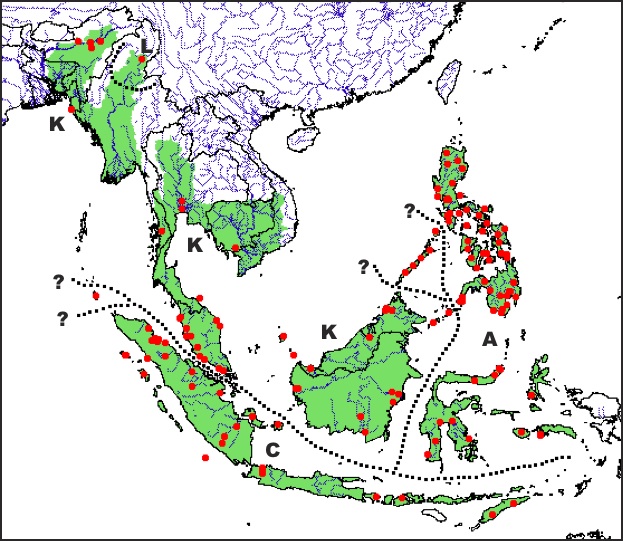Cuora amboinensis, 053
Cuora amboinensis (Riche in Daudin 1801) –
Southeast Asian Box Turtle
Sabine Schoppe1 and Indraneil Das2
1Katala Foundation Inc., P.O. Box 390, Puerto Princesa City,
PH-5300 Palawan, Philippines [[email protected]];
2Institute of Biodiversity and Environmental Conservation,
Universiti Malaysia Sarawak, 94300 Kota Samarahan, Sarawak, Malaysia [[email protected]]
Summary. – The Southeast Asian Box Turtle, Cuora amboinensis (Family Geoemydidae), is a small (straight carapace length to 25 cm), semi-aquatic turtle, largely restricted to standing water bodies of Southeast Asia, from eastern India to Indonesia and the Philippines. It has four currently recognized subspecies: C. a. amboinensis, C. a. couro, C. a. kamaroma, and C. a. lineata. The species is still relatively common in most of its range, perhaps due to its ability to adapt to a variety of habitats, including rice fields and the vicinity of human settlements. Diet includes both plant and animal matter. The species lays 1–4 large (24–34 x 44–57 mm) eggs with masses of 14–31.5 g. The considerable variation in egg size, incubation period, and reproductive season, as evident from data derived from captive breeding, is thought to be reflective of geographic variation in this widespread turtle species. The species is currently listed as Vulnerable by the IUCN Red List due to its heavy exploitation for the international food, pet, and medicinal trade, and is also included in CITES Appendix II. There is an apparently large illegal trade in the species, and many regional populations appear to be decreasing rapidly, requiring closer monitoring.
Distribution. – Bangladesh, Brunei Darussalam, Cambodia, India, Indonesia, Laos, Malaysia, Myanmar, Philippines, Singapore, Thailand, Timor-Leste, Vietnam. Widely distributed from northeast India and Bangladesh, through most of mainland Southeast Asia to the islands of East Malaysia, Indonesia, Timor-Leste, and the Philippines.
Synonymy. – Testudo melanocephala Van-Ernest in Daudin 1801 (nomen oblitum), Emys melanocephala, Clemmys (Clemmys) melanocephala, Testudo amboinensis Riche in Daudin 1801, Emys amboinensis, Terrapene amboinensis, Cistuda amboinensis, Cuora amboinensis, Cistudo amboinensis, Cyclemys amboinensis, Emys (Cistuda) amboinensis leveriana Gray 1830.
Subspecies. – Four currently recognized: 1) Cuora amboinensis amboinensis (East Indian Box Turtle, Wallacean Box Turtle) (distribution: Sulawesi and northeastern Indonesia and Philippines); 2) Cuora amboinensis couro (Indonesian Box Turtle) (synonymy: Emys couro Schweigger 1812, Terrapene bicolor Bell 1826) (distribution: Sumatra and southern Indonesia); 3) Cuora amboinensis kamaroma Rummler and Fritz 1991 (Malayan Box Turtle) (distribution: Kalimantan, Malaysia, and continental Southeast Asia); and 4) Cuora amboinensis lineata McCord and Philippen 1998 (Burmese Box Turtle) (distribution: northern Myanmar).
Status. – IUCN 2011 Red List: Vulnerable (VU A1d+2d) (assessed 2000); CITES: Appendix II, as Cuora spp.
Citation:
Schoppe, S. and Das, I. 2011. Cuora amboinensis (Riche in Daudin 1801) – Southeast Asian Box Turtle. In: Rhodin, A.G.J., Pritchard, P.C.H., van Dijk, P.P., Saumure, R.A., Buhlmann, K.A., Iverson, J.B., and Mittermeier, R.A. (Eds.). Conservation Biology of Freshwater Turtles and Tortoises: A Compilation Project of the IUCN/SSC Tortoise and Freshwater Turtle Specialist Group. Chelonian Research Monographs No. 5, pp. 053.1–053.13, doi:10.3854/crm.5.053.amboinensis.v1.2011, //iucn-tftsg.org/cbftt/.
(Adobe Acrobat 6.0 or later required)

Cuora amboinensis kamaroma from Nicobar Islands, India.
Photo by Indraneil Das.
Distribution:

Distribution of Cuora amboinensis in Southeast Asia, with dotted lines indicating approximate subspecies boundaries: A = amboinensis, C = couro, K = kamaroma, L = lineata; lines marked with question marks indicate populations on Palawan and the Nicobars, which are of questionable subspecies status and may represent intergrades. Red dots = museum and literature occurrence records of native populations based on Iverson (1992), plus more recent and authors’ data; green shading = projected distribution based on GIS-defined hydrologic unit compartments (HUCs) constructed around verified localities and then adding HUCs that connect known point localities in the same watershed or physiographic region, and similar habitats and elevations as verified HUCs (Buhlmann et al. 2009), and adjusted based on authors’ data.








